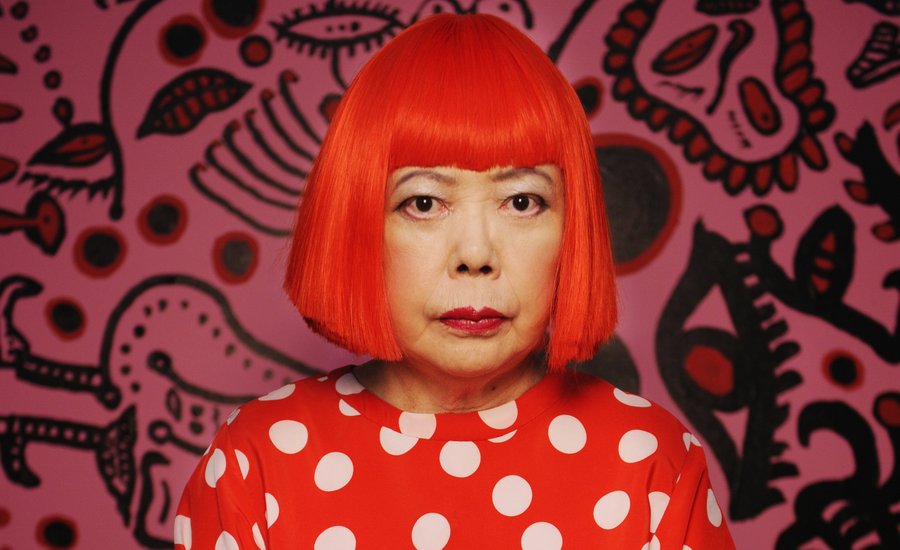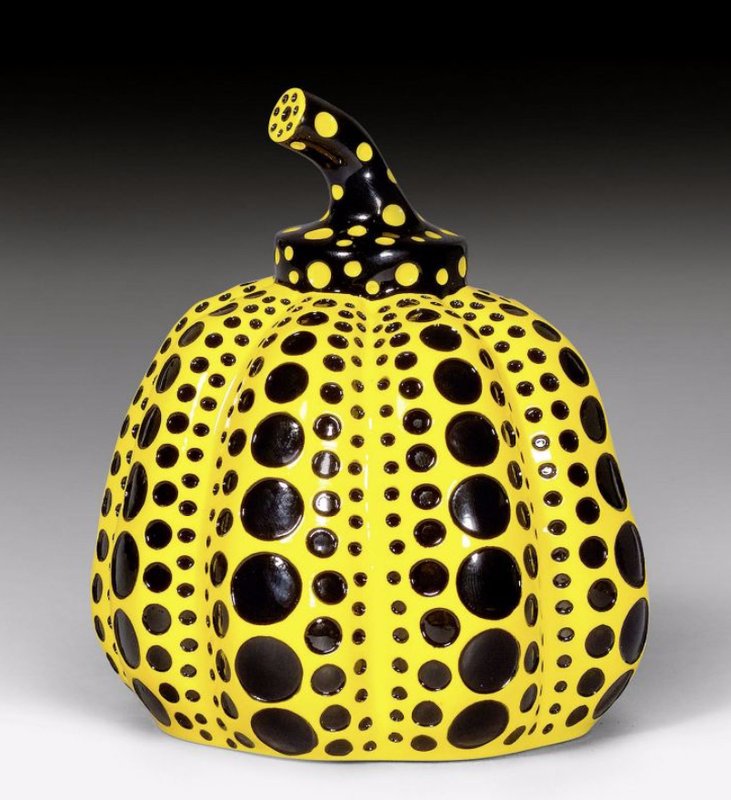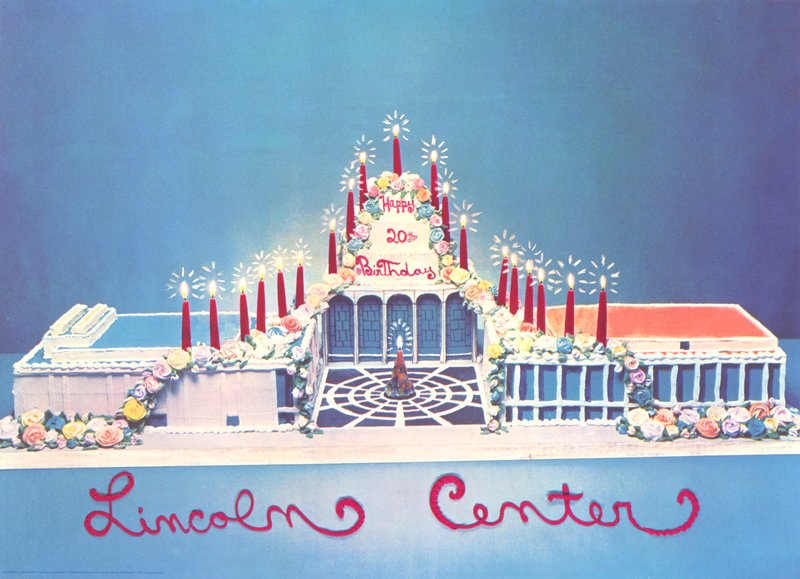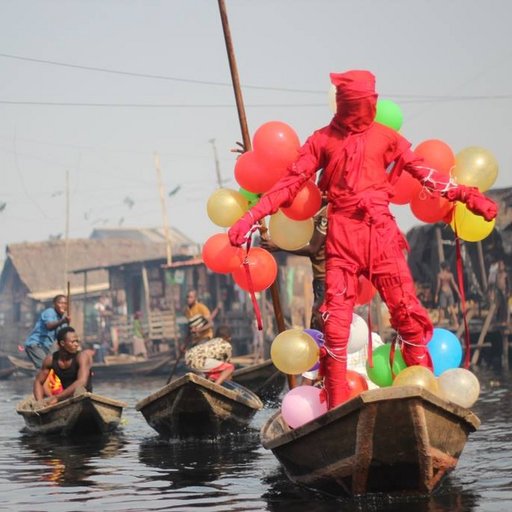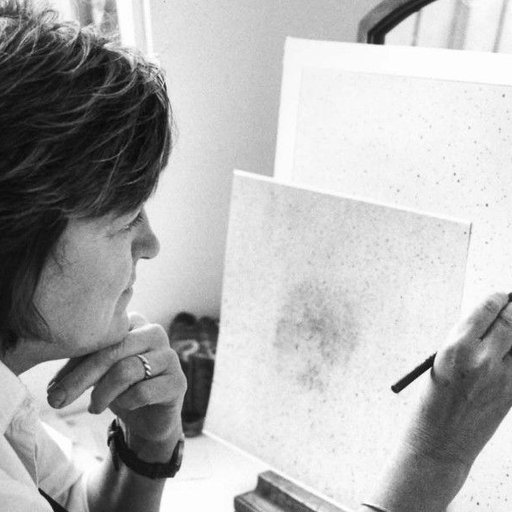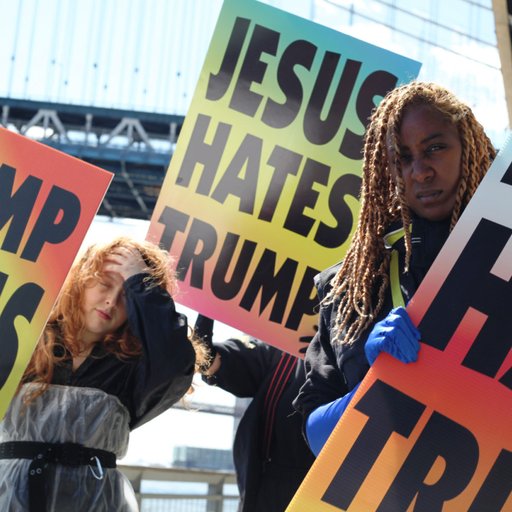Since its opening in February, the Hirshhorn Museum's exhibition "Yayoi Kusama: Infinity Mirrors" has renewed attendance at the museum, which is part of the Smithsonian Institution in Washington, DC. In its first week, the exhibition helped bring 32,500 visitors to the museum, in what the Smithsonian says is "its highest attendence for those dates in almost 40 years." In response to the exhibition's popularity, the small museum on the southern edge of the National Mall has expanded its hours for the final week of the exhibition. "Yayoi Kusama: Infinity Mirrors" closes on May 14 before traveling to the Seattle Art Museum (June 30 – Sep 10), The Broad Museum in Los Angeles (Oct 21 – Jan 1, 2018), and on to Toronto, Cleveland, and Atlanta throughout 2019.
Although the loci of the exhibition are six of Kusama's "mirror rooms"—large installations in which the artist's sculptures are reflected into infinity—also included are a representation of Kusama's paintings (including works from "My Eternal Soul," which have never been exhibited in the U.S.), sculptures (like her iconic polka-dotted pumpkins), and documentation of her Happenings in the 1960s.
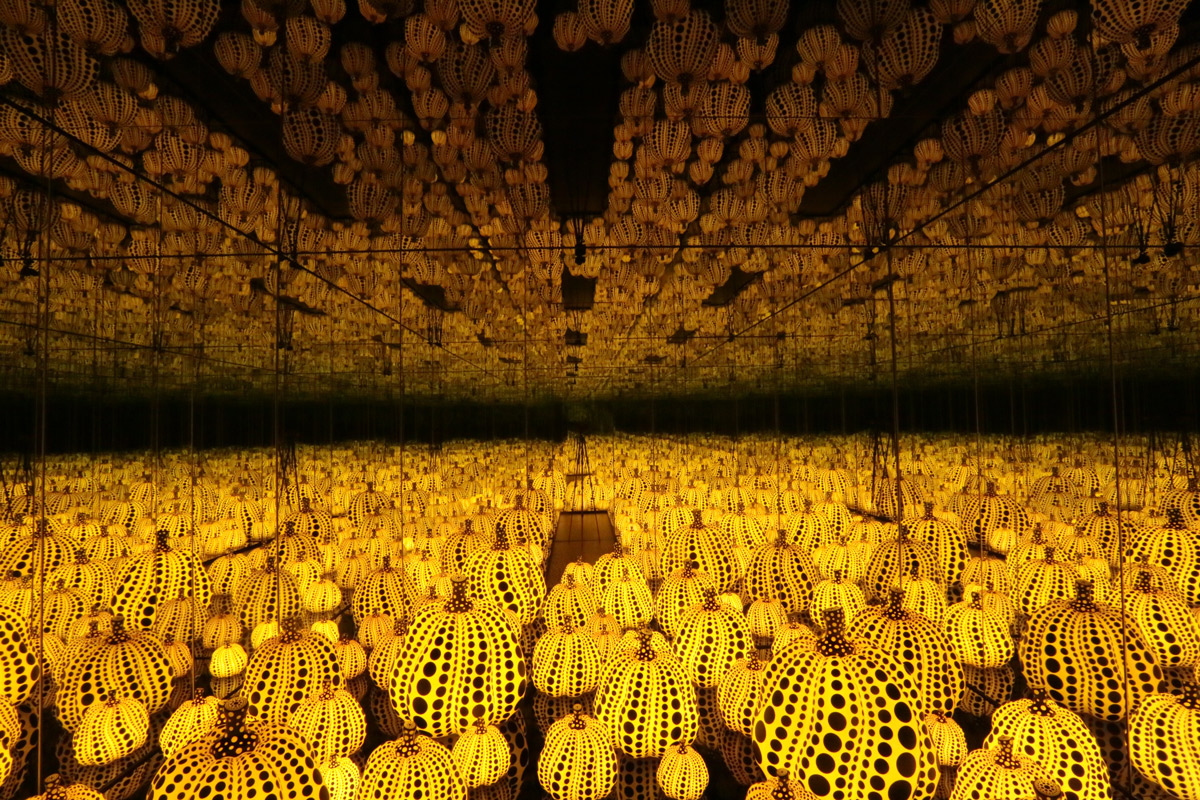 Yayoi Kusama, All the Eternal Love I Have for the Pumpkins, 2016
Yayoi Kusama, All the Eternal Love I Have for the Pumpkins, 2016
In 2000, Phaidon published Yayoi Kusama, a comprehensive monograph of the artist's work up until that point, including an interview of the artist with Japanese poet and critic Akira Tatehata. Excerpted below, the interview captures Kusama at her most personal and her most whimsical, and she discusses her work's relation to her mental illness, her resistance to identifying with larger movements, and her continued perception of herself as an outsider. Also discussed are lesser-known series: collages, collaborations with fashion designers, and poetry.
...
Ms. Kusama, after many years of being viewed as a kind of heretic, you are finally gaining a central status in the history of postwar art. You are a magnificent outsider yet you played a crucial, pioneering role at a time when vital changes and innovations were taking place in the field of art.
During 1998–99 a major retrospective exhibition of your early work ("Love Forever: Yayoi Kusama, 1958–1968") toured major museums in the United States and Japan. How did you feel when you looked at your past works again?
Well... if I were not Kusama, I would say she is a good artist. I'd think she is outstanding.
However, you had to fight one difficult battle after another before you came to this point.
Yes, it was hard. But I kept at it and I am not at an age that I never imagined I would reach. I think my time, that is the time remaining before I pass away, won't be long. Then, what shall I leave to posterity? I have to do my very best, because I made many detours at various junctures.
Detours? You may have experienced hardships, but I don't think you wasted your time. You have never stopped working.
I have never thought of that.
And each one of your battles that you fought at each stage of your life was inevitable. In fact, you yourself jumped into them.
Yes, like the Happenings I staged in New York.
First of all, I would like to ask you about the period when you were in Japan before going to the U.S. You went to New York at twenty-seven. By then, you must have already developed your own world as a painter.
Yes.
Your self-formation was grounded in Japan. Still, you did not flaunt your identity as a Japanese artist.
I was never conscious of it. The art world in Japan ostracized me for my mental illness. That is why I decided to leave Japan and fight in New York.
In any case, while in Japan you had already produced numerous works, most of which were drawings. It is true that in your encounter with New York's atmosphere your worked flourished, beginning with the spectacular large-scale canvases such as your Infinity Net paintings of the late 1950s and early 1960s. Still, the nets and dots that dominate your early New York works are clearly prefigured in the small drawings you made before your move to America. These nets and dots are predicated on a technique of simple, mechanical repetition; yet, in a sense, they also epitomize hallucinatory visions. At that time, were you interested in Surrealism?
I had nothing to do with Surrealism. I painted only as I wished.
 Kusama with "Infinity Net" painting, 1961
Kusama with "Infinity Net" painting, 1961
I once wrote that Kusama was an "autonomous" Surrealist; which is to say that without you having had any direct knowledge of the Surrealist movement, the outburst from your singular, fantastic world characteristically appeared to converge with the world of the Surrealists. To put it another way, André Breton and his colleagues began this movement by methodologically legitimizing the world of those who possessed unusual visions such as yours.
Nowadays, some people in New York call me a "Surrealist-Pop" artist. I do not care for this kind of labelling. At one time, I was considered to share the sensibility of the monochrome painters of the early 1960s; at another time I was regarded as a Surrealist. People are confused and don't know how to understand me. Regardless, some want to call me a Surrealist, trying to pull me to their side, others want me in the camp of Minimal art, pushing me in the other direction. For example: Henk Peeters, an ex-member of the European Zero Group, came to the opening reception of my exhibition at the Museum of Modern Art, New York, in 1998. He phoned his former Zero Group colleagues all over the world and told them to come and see my show; but I had no special relationship with Zero. All I did was do what I liked.
RELATED: How the Zero Group Became One of Art History's Most Viral Movements
You haven't thought much about "isms," have you?
Nil.
Yet people try to attach these labels to you.
Since I rely on my own interior imagination, I am not concerned with whatever they want to say about me.
Another question I have is: Why did you go to America in 1958, particularly after you had gained admission to the Académie de la Grande Chaumière in Paris?
I chose America because of my connections. Besides, I believed the future lay in New York. However, I had a hard time due to the restrictions imposed on foreign exchange by the Japanese government. I even sold my furisode [long-sleeved kimonos with sumptuous designs]. Georgia O'Keeffe, with whom I had corresponded since before my arrival in the U.S., was so worried that she invited me to come to her place, offering to take care of me. But I remained in New York, in a studio with broken windows at the junction of Broadway and 12th Street.
Did the various art scenes in New York excite you?
The first thing I did in New York was to climb up the Empire State Building and survey the city. I aspired to grab everything that went on in the city and become a star.
At the time, New York was inhabited by some 3,000 adherents of action painting. I paid no attention to them, because it was no use doing the same thing. As you said, I am in my heart an outsider.
Are you self-conscious at being an outsider?
Yes, I am.
To you, "outsider" must be a word of pride; to me, you are no mere outsider. It feels odd to say this in front of the artist herself, but Kusama can be considered as an artist who, seriously engaged with the art of her time, has been situated at the center of the unfolding of art history, like Van Gogh. Mere outsiders could not change history.
I had no time to dwell on which school or group I belonged to. Van Gogh would have thought little of schools when he was painting. I cannot imagine how I will be classified after my death. It feels good to be an outsider.
RELATED: How Outsider Art Entered the Inner Sanctum of World-Class Museums
Still, you had certain exchanges with other artists.
Yes. Lucio Fontana, for example, in Europe. I made some of my works at his place and he helped me with my exhibitions. Our contact lasted until his death in 1968. I borrowed $600 from him to have the mirror balls (Narcissus Garden) fabricated for the Venice Biennale in 1966. He died before I could pay him back. He spoke highly of my work; he was very kind to me. He was like that, encouraging the development of younger artists. His work is also wonderful, both his painting and sculpture.
 Kusama sells an orb from Narcissus Garden during the Venice Biennale, 1963
Kusama sells an orb from Narcissus Garden during the Venice Biennale, 1963
And in New York?
I was close to Joseph Cornell for ten years. He developed an obsession for me. When I first visited him he was dressed in a ripped sweater. I was very scared, I thought I was seeing a ghost. He had such an extraordinary appearance, and he lived like a hermit. He was unusual as an artist. He, too, was an outsider.
How about Donald Judd?
My first boyfriend. I met him in the early 1960s, when he was very poor. He was studying at Columbia University and had just begun writing criticism for Art News and Arts Magazine.
He made a very accurate observation of your work. As a formalist, he keenly discerned the spatial essence of your Infinity Net paintings—their stratified structure and oscillating sensation.
Judd was a theorist. Simply put, he could not make an ordinary kind of work. In a sense, half of his work at that time was my making. He once griped, "What shall I do now? I am at a loss." I responded, "This, this is it," kicking a square box that we had picked up somewhere and turned into our table. That gave him a hint for his box pieces. We were both extremely poor. As I recall, an armchair that became one of my Accumulation pieces was also scavenged from somewhere by him. He helped me make the stuffed phalluses from bed linen.
Later I moved to a larger studio, separated from Judd. Larry Rivers and John Chamberlain lived upstairs; On Kawara was across the hall from Chamberlain. One day I was struck by fear while I was standing in the building. I cried out: "I'm scared. Somebody, please come." There came Mr. Kawara: "Don't worry. No need to be scared, I am with you." He lay down with me. There was no sex but we held each other naked. He helped calm down my attack. My attacks became so severe that an ambulance came every night. At the hospital they recommended I see a psychoanalyst.
What was your problem?
Depersonalization. Everything I looked at became utterly remote.
Did you have the same problem while in Japan?
Yes. When I was a child, my mother did not know I was sick. So she hit me, smacked me, for she thought I was saying crazy things. She abused me so badly—nowadays, she would be put in jail. She would lock me in a storehouse, without any meals, for as long as half a day. She had no knowledge of children's mental illness.
How long did your hallucinations persist?
I still have them.
Is your work a kind of art therapy?
It's a self-therapy.
Is it fair to say that you make your work in order to gain spiritual stability and release yourself from psychosomatic anxiety?
Yes. That is why I am not concerned with Surrealism, Pop Art, Minimal Art, or whatever. I am so absorbed in living my life.
I interpret your dot motifs as representing a hallucinatory vision. In your experience, just as attacks of depersonalization bring you a vision of fear, so do these dots. Proliferating dots append themselves to scenes around you. You attempt to flee from psychic obsession by choosing to paint the very vision of fear, from which one would ordinarily avert one's eyes...
I paint them in quantity; in doing so, I try to escape.
You have also described the process as a "self-obliteration" into a world suffused with dots. Salvation through self-obliteration.
I was so desperate that I made my art during hallucinations. When I was studying Nihonga [Japanese-style painting that employs traditional glue-based mineral pigments] in Kyoto, I would go out in the rain to practice Zen, wearing only a t-shirt. I would meditate in the mud in a heavy downpour, go home when the sun came out, and pour icy water over my head. I could not work otherwise.
In some ways, my New York years were no different.
 Kusama, Lingering Dream, 1949
Kusama, Lingering Dream, 1949
Is the imagery of phallus-covered furniture related to your hallucinations?
It is not my hallucinations but my will.
Your will to cover the space of your life with phalluses?
Yes, because I am afraid of them. It's a "sex obsession."
Still, these works motivated by your interior necessity are considered to be precursors of Minimal and Pop Art. Although what people say may be of no concern to you, it is a fact in terms of chronology. Art historically, your work of the late 1950s and the early 1960s was contemporary with that of the Zero and Nul Groups and what became known as the New Tendency in Europe, with its emphasis on monochrome works.
In 1960 one of my Infinity Net paintings, Composition (1959), was included in Udo Kultermann's exhibition "Monochrome Malerei" at the Städtisches Museum in Leverkusen, Germany. Mark Rothko and myself were the only two artists from America invited to participate. I made an inquiry as to why and how I was chosen and learned that the curator saw an article in Arts Magazine that discussed my work as black-and-white painting. It was on this basis that Kultermann initially contacted me.
You yourself did not think that you were making monochrome works?
No. People made it up after the fact. My Infinity Net paintings and Accumulation works and different origins from the European monochrome works. They were about obsession: infinite repetition. In the late 1960s, I said: "I feel as if I were driving on the highways or carried on a conveyor belt without ending until my death. This is like continuing to drink thousands of cups of coffee or eating thousands of feet of macaroni... I am deeply terrified by the obsessions crawling over my body, whether they come from within me or from outside. I fluctuate between feelings of reality and unreality."
Your obsession with repetition signals both desire, and the need to escape. However, you also added: "In the gap between people and the strange jungle of civilized society lie many psychosomatic problems. I am deeply interested in the background of problems involved in the relationship of people and society. My artistic expressions always grow from the aggregation of these."
Yes.
When I say you are no mere outsider, this is not an unfounded opinion that I made up. All the more because you are an actual person who breathes the same air as we do, you were able to exert a tremendous influence. For example, you challenged the authorities of the time, as in your guerrilla event at the Venice Biennale in 1963.
Yes, what was most important about Narcissus Garden at Venice was my action of selling the mirror balls on the site, as if I were selling hot dogs or ice cream cones. I sold the balls from Narcissus Garden at $2 each. This action was done in the same spirit as my nude Happenings.
RELATED: Venice Biennales I've Known and Loved
So, in an explicit challenge to the authorities, you not only exhibited but also put your work on sale outside the Italian Pavilion—until the organizers of the Biennale stopped you. I have to confess, however, that I was mesmerized by the installation itself of Narcissus Garden, which was re-created for your retrospective in 1998–99, especially when it was displayed outdoors at the Los Angeles County Museum of Art. It radiated a beautiful, almost sanctuary-like light.
The Rockefeller Garden at the Museum of Modern Art in New York, where you staged one of your later guerrilla nude Happenings (Grand Orgy to Awaken the Dead, 1969), was at the very center of all the American art institutions. You chose your sites very pointedly.
In the Rockefeller Garden I did body painting while my models fucked a bronze sculpture by Maillol.
Although many of your Happenings bore social messages, people tended to see them as scandals. Sacred scandals, I would say in retrospect. Did you from the beginning plan to incite a scandal or was it an unexpected result?
It was not intentional. Whatever I did tended to become a scandal or a piece of gossip.
 Kusama, Grand Orgy to Awaken the Dead, 1969
Kusama, Grand Orgy to Awaken the Dead, 1969
When we think about it, these scandalous Happenings differ a great deal from your lonely toil in the studio. Whereas in your Happenings you were the leader of many participating people, in your studio you spent endless time alone, painting the Infinity Net works. It was a monotonous, solitary act. What inspired you to change your modus operandi, from the interiorized self-salvation of your early New York days to an anti-establishment, anti-institutional provocation that directly engaged society?
Since people in New York were so conservative, so narrow-minded about sex, I wanted to overturn the conventions through my demonstrations. I organized several political Happenings involving national flags. One Happening was staged in front of the United Nations building in 1968 when the Soviet troops invaded Czechoslovakia. I washed a Soviet flag with soap, because the Soviet Union was dirty.
Among your oeuvre, politically and socially oriented works were concentrated in the brief period of the late 1960s. You did little work of this kind before or after this period.
At the end of the 1960s I did think of continuing, somehow, in this direction. I was planning a Broadway musical entitled Tokyo Lee Story. The protagonist, Tokyo Lee, was me. Rocky Aoki and I attempted to set up a fundraising company. We lined up the actors and stagehands, but then, in late 1969, I became sick again. So I saw a doctor, who said that it was nothing. The psychiatrists I saw were in my opinion a mess, with their heads muddied and brainwashed by Freud. For me, they were useless clinically. I frequented them, but my illness remained as debilitating as ever. It was a waste of time. They were antiquated Freudians. All I needed form them was a piece of information about how to cure myself, which they never gave me. As they asked, I recounted to them, "My mother did this to me, did that to me." The more I talked, the more haunting the original impression became.
They didn't save you but prompted your memory to recover?
My memory became clearer and clearer, larger and larger, and I felt worse and worse.
Towards the end of the 1960s you also founded a fashion company, which marketed radically avant-garde clothes. It was a part of your art project.
Walking on the streets, I noticed many people who wore clothes which were very similar to my designs. After some investigation I identified a company called Marcstrate Fashions, Inc., which manufactured them. I met with the company's president, showed him a trunkful of my designs, and told him that his products were all imitations of my ideas. He said, "Oh, you are ahead of me, I didn't realize." Then he and I decided to make a company that specialized in my line. It was an officially incorporated company. He was Vice President and I was President.
What was it called?
Yayoi Kusama Fashion Company. The mass media reported about us big time. We did fashion shows and had a Kusama corner at department stores. Buyers from big department stores came and selected 100 of this, 200 of that, although they only bought the more conservative styles. The radical vanguard items that I poured my energy into sold little in the end.
RELATED: A History of Art & Fasion Collaborations
In the 1970s you returned, or rather moved your activities, to Japan.
I came back to Japan to have surgery. I had a foot problem. A doctor in New York didn't even give me a blood test, didn't know what was wrong.
The first time I saw your work was at Nishimura Gallery in Tokyo, where you showed your collages in 1975, soon after your return. The commonly held opinion in Japan was that Kusama had returned a loser from New York. That was completely blown away when I saw your work. It was then that I made it my curator's mission to have society rediscover this genius. It is humbling how long it has taken to realize this goal.
By the way, I wonder why your works made in New York and in Tokyo are so different? I don't mean to suggest that one is better or worse than the other. The same can be said of your early Japanese work before you went to America.
Originally, I didn't have enough space in Japan to make large works.
 Kusama, Bird, 1981
Kusama, Bird, 1981
In addition to the issue of scale, your New York work feels drier and more inorganic, whereas your Japanese work is—though I am concerned that my expression may be misleading—more literary. That is the kind of different I have in my mind.
I could not survive in New York otherwise. You cannot live there with a lyrical frame of mind.
When you came back to Japan the fantastic and lyrical aspect of your work that characterized the pre-New York works re-emerged. It is interesting that your work after New York grew increasingly younger. Your fantastic vision is beautiful yet macabre. Your New York works exude an awe-inspiring sense of scale, with literary qualities eradicated. Presenting an intensified vision marked by materiality, they have their virtue. However, when you came back to Japan, another aspect of your work emerged.
A reverse side, so to speak. It is as if another person surfaces, to complement my personality. If New York is the front side, Japan is the back.
If so, even works by an outsider artist like yourself are differently affected by their surrounding environments: New York versus Tokyo and Japan.
It's true. In Japan, I write poetry. In New York, there was no mood for poetry; every day was a struggle with the outside world. It's hell for a woman to live alone there. For example, one day when I returned to my studio I found all my belongings had been stolen; I saw my paintings suddenly appear in junk shops.
You produced no literary or poetic work in New York. Certainly New York is a theme in your works of literature but these were all written in Japan. You have published fifteen volumes of novels since your return to Japan.
I also wrote and composed songs.
Composition as well?
Yes. I bought a piano.
Did you sing them?
Not in public, but I sing them at home. One is called "Song of a Manhattan Suicide Addict" (1974). It goes like this:
Swallow antidepressants and it will be gone
Tear down the gate of hallucinations
Amidst the agony of flowers, the present never ends
At the stairs to heaven, my heart expires in their tenderness
Calling from the sky, doubtless, transparent in its shades of blue
Embraced with the shadow of illusion
Cumulonimbi arise
Sounds of tears, shed upon eating the color of cotton rose
I become a stone
Not in time eternal
But in the present that transpires
This is included in your anthology of poetry, Kakunaru urei (Such a Sorrow), 1989. Your word images are piercing. Your novels received high praise from the reputable novelist Kenji Nakagami and one of them won you a literary award for emerging writers.
He was very supportive. It is truly a great loss that he died young.
For you, what is the relationship between art and literature? Do they share anything or are they totally different?
Different.
Do you consider writing as a means of self-salvation?
No, poetry is not about self-salvation.
You mean poetry is differently motivated than art?
That is correct. When I was writing poetry in the 1970s, I was very depressed. I was on the verge of committing suicide, constantly. I consulted with a doctor in Tokyo and was advised the hospitalization was necessary.
I have one more question that will probably bore you. In recent art criticism and scholarship, there is a distinct tendency to honor you as a great forerunner of feminist art, to interpret your work within the history of feminist struggles.
I am too busy with myself to worry about a man-woman problem. Since I find a refuge in my work, I cannot be bullied by men.
 Kusama, Infinity Mirror Room: Phalli's Field, 1965
Kusama, Infinity Mirror Room: Phalli's Field, 1965
However, would you say that those who wish are free to render a feminist interpretation of you?
Yes. Although I have never thought of feminism. In my childhood, I experience so much hardship, all thanks to "feminism." My mother wielded a tremendous amount of authority and my father was always dispirited.
RELATED: 6 Black Radical Female Artists to Know
Your family was a matriarchy, with your mother at the center.
She turned the entire household into her own castle. Her children had no meaning other than as existences subordinate to hers. She was smart and very strong. She was also good at painting and calligraphy. She was a valedictorian at her school. My father was dominated by her, which he disliked. He customarily went out, he was absent at home. Yet he was a very kind father.
Psychoanalysts would have a lot to say on the subject—citing the Electra complex among other things. However, feminist discussion of your work has produced certain interpretations that cannot be ignored. Indeed your phallus-covered high-heeled shoes, handbags, and dresses are potent fetishes.
Your work also merits a formalist analysis, as articulated by Donald Judd, for example, and furthermore it has the impact, which we have discussed, or art that comes from an outside. You are at once a part of the New York scene and closely connected to the European trends of the 1960s. You are regarded as a progenitor of feminist and issue-oriented art. Your work allows all the inherently contradictory discourses, yet it departs from them all. You are an artist outside the given boundaries. It may take a little more time to comprehend the whole body of work.
I have had so many hardships, with people saying various things about me. Time is finally turning a kind eye on me. But it barely matters, for I am dashing into the future.
[related-works-module]











